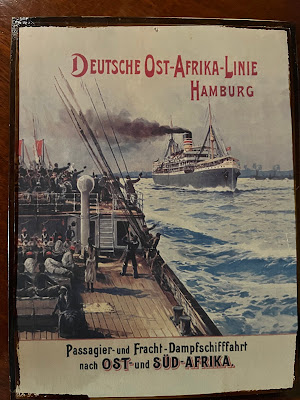Annamaria on Monday
To make my time-machine stories work, I have to get myself to the point were I feel l]as if I am there with my characters in their historical lives. Fortunately, when it comes to East Africa at the beginning of the 20th Century, I have found lots of tickets to get me there.
Sometimes, they just show up in my life - like magical gifts. For instance, the metal placard pictured above. It's a 7x9 inch reproduction of a travel poster from around 1910. Since I acquired it, it has sat on the bookshelf about my computer. I bought it during a visit to Rome. At the time, I was working on the beginning of Idol of Mombasa. which takes place in the port city of British East Africa in 1912. I had researched how people went from Europe to BEA, so I knew what shipping and passenger lines plied those waters. I had already drafted the first scene. In it, my Vera and Tolliver are returning from their honeymoon.
"...On shore, a military band, augmented by native drummers, struck up a tune that Vera did not recognize.
"Oh, look," Justin exclaimed, "someone of note is arriving on that Deutsche Ost-Afrika boat..."
Then, on a sunny afternoon in Rome, when I was not thinking about that scene, while strolling on a favorite street from Piazza Navona to Ponte Sant'Angelo, suddenly, there it was. On rack outside a stationery and gift shop.The very ship, black smoke from the coal boilers and all. My next sentence to my fellow travelers began, "Oh, look..."
These days, I am putting the finishing touches on A Death on the Lord's Day, due out in late August. My favorite source of information on everyday life in BEA is close at hand.
I first found this goldmine in the indispensable collection of the New York Public Library. Thanks to the University of Michigan Library, I now have my own reprint.
So, for instance, when my characters take the train, I can look up when they will depart and when they will arrive at their destination. That is, unless the track has been bent out of shape by crossing elephants or dug up by a rhino.
I can easily look at the organization of the Brits in charge, and even know their actual names.
In the upcoming book, Vera and Tolliver are establishing their farm, part of which is going to be pasture for cows. The Handbook of BEA tells what a settler needs to do to succeed. Among the pages of advice, the experts highly recommend Paspalum Dilatatum for dairy farms.
In those days, pastures were cleared and planted with the a native grass of Ceylon. Seeds were availalbe from Australia. Once the introduced plant took hold, it would provide fodder for the large herds needed for a highly profitable dairy farm.
Of course, I looked it up, to see what its common name might be today. It is now called Dallis Grass. And it is condemned as a highly invasive species in the USA. In my research, I haven't found any similar contemporary complaints about it in Kenya. Perhaps, someone out there will who knows about it, will clue me in.
In the meanwhile, my characters are taking the advice of the 1913
"experts," and they are planting the recommended species for their cows.




















What a wonderful resource to discover.
ReplyDeleteLooking forward to the new book!
Thank you, Michael. NYPL’s collection is so vast and thorough that I found incredible treasures there. One is a memoir of a policeman in 1909! That the the Handbook have been and are goldmines.
DeleteHow exciting to discover both the pictorial inspirations and the historical documents to feed realistic detail into your characters' surroundings!
ReplyDeleteHow lovely to hear from someone who understands, Eleanor! Some people wrinkle their noses and ask how I can stand doing so much research. For me, it’s the little historical details that sing the story to me.
Delete